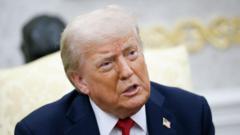Despite ongoing trade tensions, China's economy recorded a 5.2% growth in the second quarter, slightly surpassing predictions but still indicating a cautious outlook for the future.
China's Economy Surprises with Resilience Amid Trade Tensions

China's Economy Surprises with Resilience Amid Trade Tensions
China's recent economic growth shows unexpected strength in the face of looming US tariffs and real estate challenges.
China’s economy has shown surprising resilience, navigating through pressures from President Donald Trump's tariffs and a persistent crisis in the property market. Recent statistics indicate that the world's second-largest economy grew by 5.2% in the three months leading to June, outperforming the economists' average forecast of 5.1%, although this marks a decline from the previous quarter's results.
Support measures implemented by Beijing and a tentative trade truce with Washington have helped the economy avoid a significant downturn. The National Bureau of Statistics highlighted that the economy has "withstood pressure and made steady improvement despite challenges". Key growth drivers included a 6.4% surge in manufacturing fueled by increased demand for sectors like 3D printing, electric vehicles, and industrial robotics. Furthermore, the services sector, encompassing transport, finance, and technology, also reported gains.
However, June retail sales growth decelerated to 4.8%, down from a 6.4% year-over-year increase in May, indicating some slowing consumer enthusiasm. Additionally, the property market continues to struggle, with new home prices falling at the fastest monthly rate in eight months, revealing ongoing struggles in China's real estate sector.
Despite these challenges, experts had anticipated a more substantial impact from the tariffs, noting that China has demonstrated considerable resilience. Gu Qingyang, an economist at the National University of Singapore, stated that growth was further reinforced by a spike in exports, as companies expedited shipments in anticipation of potential new tariffs or shifts in China's export strategies.
Looking ahead, the second half of the year might present increased uncertainties, which could necessitate more robust government stimulus. Nevertheless, maintaining the 5% annual growth target seems within grasp, though some economists predict that China may struggle to meet this objective. Dan Wang, director for China at the Eurasia Group consultancy, remarked that a minimum growth floor of 4% remains politically viable.
The ongoing tariff conflict between Presidents Xi Jinping and Trump has led to the implementation of heavy levies—over 145% on Chinese goods imported into the US—and retaliation from Beijing with a 125% duty on certain US products. While these tariffs were temporarily suspended following negotiations, both countries face a deadline of August 12 to finalize a long-term trade agreement amidst additional tariffs affecting countries closely linked to China's economy.




















